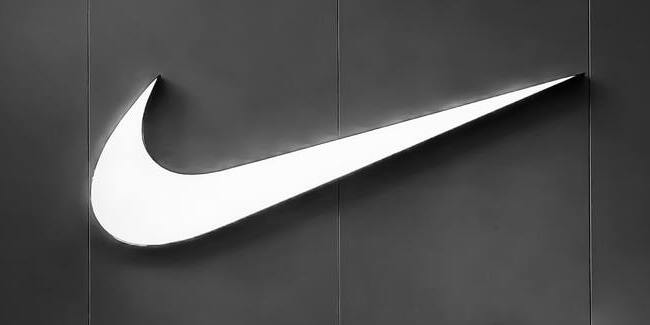Aren't there enough pieces attempting to extract the secrets of success from the global sportswear gorilla that is Nike? Yes; yes there are. But maybe that's the problem.
Many marketers in search of guidance on how to grow their business will look to brand giants like Nike for lessons (or Apple, Facebook, Amazon, etc. — but for the sake of consistency, we'll use Nike as our model in this article). It's so tempting to emulate every branding or marketing move they make with the mindset of, "If that's how Nike does it, we should follow suit. They've got to be doing something right!"
And obviously they are doing something (if not everything) right; I hope I'd get fired if I said that Nike didn't know a thing or two about building a brand, and everything it takes to create one of the most powerful businesses to ever exist. And we are absolutely going to analyze the timeless brand positioning elements that Nike has used to create their household-name status.
The difference is, we are going to assess how to leverage those same core elements in the context of your brand’s size and place in the market. Because the reality is, a company like Nike is worlds apart from most in terms of reach, clout, market-share, industry, budget, product type, etc.
We'll also discuss the tactics that a powerhouse like Nike can get away with and thrive on, while emulating those would likely send your customers spiraling into confusion and your revenue into oblivion.
Let’s dive in.
What We'll Cover:
- What Is Brand Positioning?
- What Brand Positioning Strategies Did Nike Use to Build an Empire?
- The Tactics That Will Work for Your Brand
- The Tactics That You Should Not Emulate
- Brand Positioning Checklist
What Is Brand Positioning?
Alright, before we have the conversation around Nike's brand success, we need to set some ground rules around the language we use. There are many different ways to define ‘brand positioning,’ but for the sake of discussion, we'll borrow the words of brand genius, Philip Kotler: "Brand positioning is the act of designing the company’s offering and image to occupy a distinctive place in the mind of the target market." More simply, brand positioning is the 'thing' your brand is known for by customers.
 But why does that matter? Won't customers know that simply by going to your website? Somewhat. But brand positioning sets you apart from the hundreds of other businesses who offer something similar. It’s brand positioning that ultimately differentiates and implies value.
But why does that matter? Won't customers know that simply by going to your website? Somewhat. But brand positioning sets you apart from the hundreds of other businesses who offer something similar. It’s brand positioning that ultimately differentiates and implies value.
It might be more useful to explain through a brief exercise. I'll present a few questions, you answer with the first thing that comes to mind, and let's see if we come to similar conclusions.
- When you want the cheapest hamburger, where do you go?
- What is the best cell phone in the world?
- When you need the cheapest flight possible, which airline do you book?
Okay, my answers: 1) McDonald's, 2) iPhone, 3) Spirit Airlines
Now, for each of those answers, subjectivity and debate will forever remain a factor, but most would agree that McDonald's is at least top of mind for the cheapest hamburger, the iPhone dominates the cell phone market, and though you may have said something like Frontier or Allegiant for the cheapest airline, Spirit is obviously up there.
That is brand positioning. And if your customers clearly understand the specific problem you solve, and how you do it better than any other brand, you're setting yourself up to win their business and take more market share. That's why it matters if you want to grow your brand.
👉 Download the Brand Assessment Worksheet to start setting your brand apart.
What Brand Positioning Strategies Did Nike Use to Build an Empire?
If you push aside the infinite volume of campaigns, product launches and celebrity endorsements, you can begin to identify the essential and timeless strategies that Nike has used to become who they are today.
A Clear Vision for Something Greater
A quick refresher for those that may not know the inception story of Nike: In 1964, the University of Oregon track-and-field coach Bill Bowerman, along with one of his athletes at the time, Phil Knight, identified a need for a better running shoe than was available on the market — one that was optimized specifically for running performance. After a few designs and beta tests, the shoe built some traction (no pun intended) with the ideal user of the newly designed shoes — runners at the University of Oregon (most notably Otis Davis, who laced them up to win a gold medal in the 1960 Olympics). And the rest is history.
But within that classic narrative lies a nugget of insight into the true brand essence of Nike, and more importantly, the leading reason they are who they are today. And no, it's not the difference of a few grams of weight in the soles, and it's not even that iconic swoosh logo. It's found in the reason shoe was even made in the first place — and for whom.
Bowerman was known to 'tinker' incessantly with his runners' shoes, making little tweaks and experimenting with optimizing the performance capacity of each pair. He wanted to leverage whatever resources and ideas he could to push the limits of what was possible and achievable for athletes.
Likewise, these were collegiate, and in some cases Olympic, athletes that wanted to accomplish great things on the track and set a higher standard for performance.
It's this common character trait that defines Nike's success — the desire to achieve something greater. The need to constantly improve and conquer is the deepest root of Nike's heritage. That’s Nike’s brand essence, and it’s been their positioning since their inception.
It's the reason the famous tagline "Just Do It." holds so much weight, and why the brand promise, "To bring inspiration and innovation to every athlete in the world.” is still as true today as it ever has been for the brand.
Knowing Their High-Expectation Customer (HXC)
Even in the earliest stages of their brand, Nike understood what they were trying to accomplish, and by doing so began to form their own niche in the world. Without even knowing it, they were painting a vivid image of their target audience and ideal user. These individuals demand the most of a brand, and yet are equally the ones who passionately support it, if not evangelize on its behalf. They do this because their desire for something greater aligns with their expectations for a brand to deliver. This is known as the High-Expectation Customer (HXC).
Julie Supan, one of the most sought-after brand positioning and GTM experts in Silicon Valley, coined the term and shares why a brand that understands and focuses on its HXC will not only build a passionate audience but a loyal following that spreads the word for them.
“The high-expectation customer, or HXC, is the most discerning person within your target demographic. It’s someone who will acknowledge — and enjoy — your product or service for its greatest benefit." She follows, “If your product exceeds their expectations, it can meet everyone else’s.”
There's plenty more to be learned about the HXC, but all we need is the main idea to help us clear the clutter and understand that what is at the core of Nike's brand positioning is not a shoe.
It’s obvious that Nike's marketing strategy extends far beyond the Cristiano Ronaldos and Michael Jordans of the world. Though these world-class athletes are grouped into Nike's HXC, Nike is by no means limited to such athletes. Nike products are seen just as much at a middle school lacrosse game as they are on the pitch of the world cup.
 Nike is a brand for athletes who are achieving something greater than they ever have or anyone else ever has, on the highest level possible. If they can meet the needs of those athletes, they can and will meet the needs of any athlete with that same desire, no matter the level of play.
Nike is a brand for athletes who are achieving something greater than they ever have or anyone else ever has, on the highest level possible. If they can meet the needs of those athletes, they can and will meet the needs of any athlete with that same desire, no matter the level of play.
It's this methodology that allows Nike the freedom to play outside the lines of traditional and rigid market segmentation. Of course, they may have personas defined for their internal marketing strategy, but their external marketing mix is based on the single-most essential thing their ideal users have in common — the desire to achieve something greater.
Making Their Customer Central to Their Brand
You'll never hear a scientific lecture on the ground-breaking features or new technologies in a Nike commercial and you won’t see statements about how Nike is better than Adidas, Under Armour, Puma or any other sports equipment competitor in their marketing campaigns.
What you will find is story after story of athletes accomplishing something. All that's needed to communicate the truth and power of this approach is to play the tape.
Just watch this.
Or this.
And this.
If that's not enough, just keep watching these.
These are more than just high-production-value campaigns. They utilize the most simplistic and effective method of modern marketing: making the customer the center of the brand.
Nike's branding and marketing is all about the story of their customer's journey — the desire, the challenges, the failures, the successes. Nike is the 'guide,' or the support system that inspires their customers to go after their dreams and innovates tools to do it.
Known for the One Thing
That headline alone is sure to cause some confusion. Because anyone not living under a rock knows that Nike does much more than 'one thing.' The entire Nike, Inc. ecosystem spans every sports market from skateboarding to hockey, and houses brands from Air Jordan to Converse. So how can anyone state they're known for one thing?
I argue because it has nothing to do with their various forms of athletic shoes or clothing categories. Sure, all those entities and sub-brands contribute to a massive brand value, but that has nothing to do with their positioning and their true competitive advantage in their markets. Because as we mentioned earlier, brand positioning is the space you take up in your target customer's mind.
Nike’s space is inspiration and innovation. That's the thing they're known for. Their entire strategy and every decision they've made has been to support and protect that position. It requires relentless innovation, extreme discipline in brand consistency, and years' worth of building — and carefully maintaining — a worthy heritage.
And even though most brands are not and never will be the cultural power player that Nike is, there is a crucial takeaway from this. You cannot form a strong brand position casually or half-heartedly. Once you decide who you are, where you're going and who you're taking with you, you must protect and support that decision in every single move your brand makes. Don't miss that — every single move. That includes who you hire, font choices, messaging, social channels, ambassador reputation, sales processes, internal communications ... literally everything.
The Tactics That Will Work for Your Brand
Great. We've discussed what makes Nike great. What about you?
Aforementioned, it's unlikely you'll have the empire-esque platform that Nike has created for themselves. Your brand or industry may not be as sexy as athletic wear; you may not even be in the DTC space. So how do you take principles from a brand giant like Nike and leverage them effectively in the context of your own brand?
Define Your Ideal User
If I had to defend my career by stating that there is only one crucial element of effective brand positioning, well, I'd lose my job. But for the sake of hypothetical dialogue; it's the HXC — your ideal user.
I won't go on again about why this is practically non-negotiable, but just to reiterate, here's the TL;DR: if you understand your HXC and serve them well, you will have strong brand positioning and drive more commerce.
What I believe will add more value to this article though is to share how to define your HXC. As a Brand Strategist, this is the most frequent inquiry I receive. It comes in various forms.
"Do we define our 'current' customers, or who we 'want' to work with?"
"We have multiple types of customers, how do we define only one?"
"We can't read our customers' minds, so how do we confidently know what they want?"
All these concerns are extremely important, valid and real. In fact, when such questions are presented, it usually allows for more fertile 'mental soil' in which a deeper and more authentic understanding of the brand's true position can be determined.
There are two ways to navigate those concerns or any that are similar. The first to answer the right questions about your ideal user from what you know.
- What does your customer want most as it relates to what you offer?
- What is their biggest challenge that gets in the way of what they want?
- Why do they choose you over anyone else?
The above questions start with the psyche of your target audience already in mind and offer a fitting approach for those who have a bit of data on their target audience's psychograph.
The second approach reverses the thought process. Instead of starting by guessing the psychograph of your customer, start with what your brand does well, what you want to do, and who you want to serve. By beginning the process this way, you can identify the essence of your brand and what you want it to be. From there, you can go back and create messaging that frames your brand to answer the questions mentioned in the first approach. You'll organically begin to define and attract your ideal user/HXC. Here are a few questions that you'll need to answer using this methodology.
- What's your opinion on what needs to change in your industry? What are you doing to change it?
- What's the one thing you do better than anyone else?
- What’s the single biggest problem you solve?
- How do you specifically solve that problem?
- Why does what you do matter?
These questions are the starting point for creating strong positioning. They may sound simple, but if answered correctly, they yield enough power to create the most dominant brands in the world.
Make Your Customer the Hero
No one buys what you're selling because it's objectively awesome; they buy it because they believe it makes them awesome. Or smart, or likable, or healthier, etc., etc. Regardless of the application, people are only interested in buying something if it clearly benefits them in some way. So why would any of your brand positioning be about anything else?
No matter the context of industry or business model, the moment you stop talking about your customer's wants, needs, and challenges is the same moment they stop paying attention to you.
Solve a Problem
Having a brand means having a point of view. And that point of view is your take on how a problem is best solved. But there are many brands that would disagree. They'd state that they don't solve a 'problem.' Rather, they inspire, or innovate, or push the limits, or create a new status quo...
But I'll argue that across any industry, distribution channel or business model, to have a brand is to solve a problem. There are just two different ways to position the solutions to problems, which I'll refer to as deficit and surplus.
Deficit Problems
These are pain points that represent the truest sense of the word 'problem.' They are clear points of friction that an individual faces and they are obvious because of the physical, mental or emotional pain it causes them. Brands that fall within this category often offer solutions with extremely high relevance and demand since the target audience is well aware of the challenge, would identify it as such, and welcomes a solution.
Products like tissues, duct tape, gasoline, toothpaste, locksmiths, car insurance, glasses and light bulbs solve deficit problems, because the majority of people need these things. Brands that solve these types of self-evident problems often face the most competition and have the hardest time differentiating, but the product-market fit is more than established.
But there is another type of problem brands solve that is not really perceived as a 'problem' at all — surplus problems.
Surplus Problems
How would you describe the problem a high-end fashion designer solves?
Any attempt to answer the question as it's phrased would result in a description that sounded ignorant, borderline foolish and would undermine the fashion industry altogether. Because even though it addresses a proven demand, no one would describe a lack of high-end fashion as a 'problem;' it sounds too pretentious.
Instead, a brand keen on the psychology of selling and knowledgeable of their HXC would say something like "our line of fashion helps you stand out in a crowded world — to find uniqueness among bland design" (or something suave like that). The point is, it still solves the problem of a lack of unique clothing to express oneself differently, but it's not stated as a 'problem' because the lack does not inflict direct pain, it just robs someone of the opportunity to experience something greater.
This is why I refer to it as a 'surplus.' It offers a solution to something that does not yet exist in someone's mind as a perceived problem, but offers them a newer and greater experience than they currently have. Brands in this category are often innovators and startups with new ideas. They don’t usually face much difficult with differentiation, but more so have to overcome the challenge of relevance with consumers.
Nike is one of those brands. As are names like Tesla, Apple, Google, Uber, YouTube. The beauty of these offerings is not that the world needs them, but wants them. However, it is up to the brands to communicate and create awareness of the problem (usually presented as an opportunity) in order to build traction.
Whichever category your brand falls into, it’s helpful to know which problem you solve and how to best build traction and interest around it.
Have a Clear Positioning Statement
Some brands do this better than others. The ones that do it well, if they are disciplined in protecting and communicating it, hold a stronger position in the minds of their target audience. It aligns their team, removes confusion for their customers, and creates a consistent customer experience.
For Nike, that's "To bring inspiration and innovation to every athlete in the world.”
First, notice how clear it is. Sure, the vision is extremely broad, but it clearly states who they are helping and what their goal is.
It's also critical to notice something else about Nike's brand positioning statement. When you read it, you're not surprised or confused. It's almost as if that is the image Nike has created in the minds of customers first, and then just put words to it. That's no accident and it's exactly how you should approach your brand positioning statement. Your positioning is found in your purpose, and your purpose should be in your DNA long before you put words to it.
Your brand positioning statement is just that, it's a statement that reflects your positioning. And your positioning is based on the specific problem you solve. A strong positioning statement should address your place in the world by communicating some combination of who you are, what you do, why it matters.
The Tactics That You Should Not Emulate
Vague Brand Marketing
On any given trip down the local highway, you might notice a Nike billboard every now and again. Sometimes they have powerful images of athletes, other times it's emotionally charged messaging. In some cases, it's just their logo.
A commonality in Nike's brand building is how removed it is from what Nike actually sells: shoes, clothing and equipment. How can they do that and still be so successful?
Unsurprisingly, it's because of how much brand awareness, presence and association Nike has. It's one of the biggest brands to ever exist and there are very few people on the planet who are not familiar with Nike and what they're about. That's why they can use such vague and open-ended brand marketing.
Most businesses, however, can not and should not emulate Nike’s approach here. Unless your brand carries similar clout, your branding and marketing must remain clear about what you do and the value you bring to your customers.
Serve Multiple Vertical Markets
In an ideal world, brand budgets would be infinite and market share would have no cap. But we digress back to reality, where marketing dollars must be purposeful and everyone can't be everything.
As we mentioned earlier, Nike does indeed serve many, many markets. They're in team sports apparel and shoes, fashion and culture, skateboarding and surf — you name it, they've done it (exaggerated for effect). But Nike did not start that way. They built their earlier success by becoming excellent and known for one product. Then, only once they had proven margin and built enough healthy capital, did they extend their product line, acquire other companies and explore new markets.
But any young, or even maturing brand, will not have the capital or enough perceived value to do the same. Figure out what your brand strengths are and what you want to do — your essence, your passion — and become absolutely world-class at that. Become so much better at it than everyone else that no one could ever catch up. Assuming your offering has the product-market fit, you'll create the differentiation you need to build traction and capital while protecting your brand from losing market share to copycat brands.
Then, and only then, should you consider exploring new markets.
Brand Positioning Checklist
That was a long read. So here's a recap of the main concepts covered to think about as you consider your brand positioning.
- Solve a Problem
- Have a Clear Brand Position
- Define Your Ideal User/High-Expectation Customer (HXC)
- Put the Customer at the Center of Your Brand
- Keep Your Branding and Marketing Clear
- Become World-Class at One Thing








